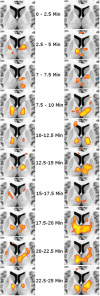Ketamine-Induced Modulation of the Thalamo-Cortical Network in Healthy Volunteers As a Model for Schizophrenia
- PMID: 25896256
- PMCID: PMC4576520
- DOI: 10.1093/ijnp/pyv040
Ketamine-Induced Modulation of the Thalamo-Cortical Network in Healthy Volunteers As a Model for Schizophrenia
Abstract
Background: Schizophrenia has been associated with disturbances of thalamic functioning. In light of recent evidence suggesting a significant impact of the glutamatergic system on key symptoms of schizophrenia, we assessed whether modulation of the glutamatergic system via blockage of the N-methyl-D-aspartate (NMDA)-receptor might lead to changes of thalamic functional connectivity.
Methods: Based on the ketamine model of psychosis, we investigated changes in cortico-thalamic functional connectivity by intravenous ketamine challenge during a 55-minute resting-state scan. Thirty healthy volunteers were measured with pharmacological functional magnetic resonance imaging using a double-blind, randomized, placebo-controlled, crossover design.
Results: Functional connectivity analysis revealed significant ketamine-specific changes within the thalamus hub network, more precisely, an increase of cortico-thalamic connectivity of the somatosensory and temporal cortex.
Conclusions: Our results indicate that changes of thalamic functioning as described for schizophrenia can be partly mimicked by NMDA-receptor blockage. This adds substantial knowledge about the neurobiological mechanisms underlying the profound changes of perception and behavior during the application of NMDA-receptor antagonists.
Keywords: functional MRI; glutamate; ketamine; schizophrenia; thalamus.
© The Author 2015. Published by Oxford University Press on behalf of CINP.
Figures




References
-
- Abel KM, Allin MP, Kucharska-Pietura K, David A, Andrew C, Williams S, Brammer MJ, Phillips ML. (2003) Ketamine alters neural processing of facial emotion recognition in healthy men: an fMRI study. Neuroreport 14:387–391. - PubMed
-
- Adolphs R. (2003) Investigating the cognitive neuroscience of social behavior. Neuropsychologia 41:119–126. - PubMed
-
- Alonso-Solís A, Corripio I, de Castro-Manglano P, Duran-Sindreu S, Garcia-Garcia M, Proal E, Nuñez-Marín F, Soutullo C, Alvarez E, Gómez-Ansón B, Kelly C, Castellanos FX. (2012) Altered default network resting state functional connectivity in patients with a first episode of psychosis. Schizophr Res 139:13–18. - PMC - PubMed
-
- Anticevic A, Gancsos M, Murray JD, Repovs G, Driesen NR, Ennis DJ, Niciu MJ, Morgan PT, Surti TS, Bloch MH, Ramani R, Smith MA, Wang XJ, Krystal JH, Corlett PR. (2012) NMDA receptor function in large-scale anticorrelated neural systems with implications for cognition and schizophrenia. Proc Natl Acad Sci U S A 109:16720–16725. - PMC - PubMed
-
- Behrens TE, Johansen-Berg H, Woolrich MW, Smith SM, Wheeler-Kingshott CA, Boulby PA, Barker GJ, Sillery EL, Sheehan K, Ciccarelli O, Thompson AJ, Brady JM, Matthews PM. (2003) Non-invasive mapping of connections between human thalamus and cortex using diffusion imaging. Nat Neurosci 6:750–757. - PubMed
Publication types
MeSH terms
Substances
LinkOut - more resources
Full Text Sources
Other Literature Sources
Medical
Research Materials

